Giáo trình Luật đầu tư quốc tế
Sau khi phác họa được khái niệm ‘đầu tư’ trong các IIA hiện hành tại Mục
1, Mục 2 của Chương này sẽ giải quyết mối quan hệ giữa toàn cầu hóa và
đầu tư quốc tế. Mục 3 sẽ bàn về lịch sử phát triển của Luật đầu tư quốc
tế. Mục 4 tập trung xác định phạm vi điều chỉnh của các IIA. Cuối cùng,
Mục 5 sẽ mô tả các nguồn của Luật đầu tư quốc tế.
Mục 1. KHÁI NIỆM ‘ĐẦU TƯ’ TRONG CÁC HIỆP ĐỊNH ĐẦU TƯ QUỐC TẾ
Khái niệm ‘đầu tư’ không phải là một định nghĩa được chấp nhận rộng
rãi mà nó thay đổi liên tục do sự ra đời và phát triển của các hình thức
đầu tư mới của các doanh nhân, các nhà tài phiệt và các công ty đa quốc
gia. Vì không có một định nghĩa được chấp nhận chung về đầu tư, nên
định nghĩa như thế nào khái niệm này trong các BIT có ý nghĩa hết sức
quan trọng.
Thông thường, các quốc gia đều cho rằng đầu tư quốc tế là việc
huy động một nguồn lực trong một khoảng thời gian nhất định để tạo
lợi nhuận trong tương lai. Trong khi đó, các định nghĩa pháp lý được sử
dụng trong các IIA thường có rất nhiều biến thể, khác nhau về cơ bản.
Những khác biệt này có thể được phân thành hai nhóm lớn, tùy thuộc
vào mục đích của IIA. Nhóm thứ nhất là các hiệp định có đối tượng là
việc dịch chuyển vốn và nguồn lực qua biên giới. Trong nhóm này, khái
niệm ‘đầu tư’ thường được định nghĩa rất hạn chế, trong đó nội dung
chính là cơ chế kiểm soát doanh nghiệp. Nhóm thứ hai gồm các IIA
hướng tới mục tiêu bảo hộ đầu tư, vì vậy các IIA này có xu hướng đưa ra
các định nghĩa rộng và khái quát hơn, dựa trên yếu tố tài sản, bao gồm
không chỉ các khoản vốn dịch chuyển qua biên giới, mà còn các loại tài
sản khác. Nhìn chung, các BIT chủ yếu tiếp cận theo nhóm thứ hai. Các
IIA gần đây nhất thường sử dụng một định nghĩa tương đối chuẩn mực
về FDI. Các hiệp định này bắt đầu xuất hiện từ những năm 1960, và kể từ
đó tới nay hầu như không thay đổi.
Trong tất cả các định nghĩa về đầu tư, cụm từ được sử dụng nhiều
nhất là ‘bất kỳ loại tài sản nào’.1 Định nghĩa này thường đi kèm một danh
mục tài sản. Vì một số lý do, danh mục các tài sản được bảo hộ trong một
BIT thường không cố định. Thứ nhất, ‘tác giả’ của các BIT đều phải thừa
nhận rằng rất khó để xây dựng một danh mục đầy đủ. Thứ hai, người ta
đã rất thận trọng khi để mở khái niệm ‘đầu tư’, để nó có thể áp dụng với
các hình thức đầu tư mới phát sinh sau này. Thêm nữa, một định nghĩa
khái quát sẽ giúp tránh được việc phải đàm phán lại BIT trong các tình
huống đó. Đối với nhiều BIT, đây là cách tiếp cận vừa mang tính tổng
hợp, vừa có ý nghĩa phân tích, có khả năng bao hàm mọi yếu tố đa dạng
có thể được coi là một khoản đầu tư. Do đó, còn một vấn đề khác nữa
mà nước tiếp nhận đầu tư cần xem xét, đó là liệu quốc gia đó có muốn
chấp nhận một định nghĩa mở về khái niệm đầu tư hay không? Vì nếu
làm như vậy, trong tương lai, nó sẽ bảo hộ được những hình thức đầu
tư mà các bên không có thoả thuận cụ thể nào ở thời điểm ký kết BIT.
Tình huống này đã được tính đến trong quá trình đàm phán MAI trong
khuôn khổ OECD, đặc biệt đối với các tài sản tài chính. Nhân dịp này,
người ta đã nhấn mạnh rằng có lý do chính đáng để đưa các hình thức
đó vào trong BIT, miễn là các khoản đầu tư được thực hiện để thiết lập
quan hệ kinh tế lâu dài với doanh nghiệp. Tương tự, các nước tiếp nhận
đầu tư có thể thấy không thích hợp, khi bảo hộ các quyền theo giấy
phép ở mức độ tương tự với các tài sản nước ngoài khác
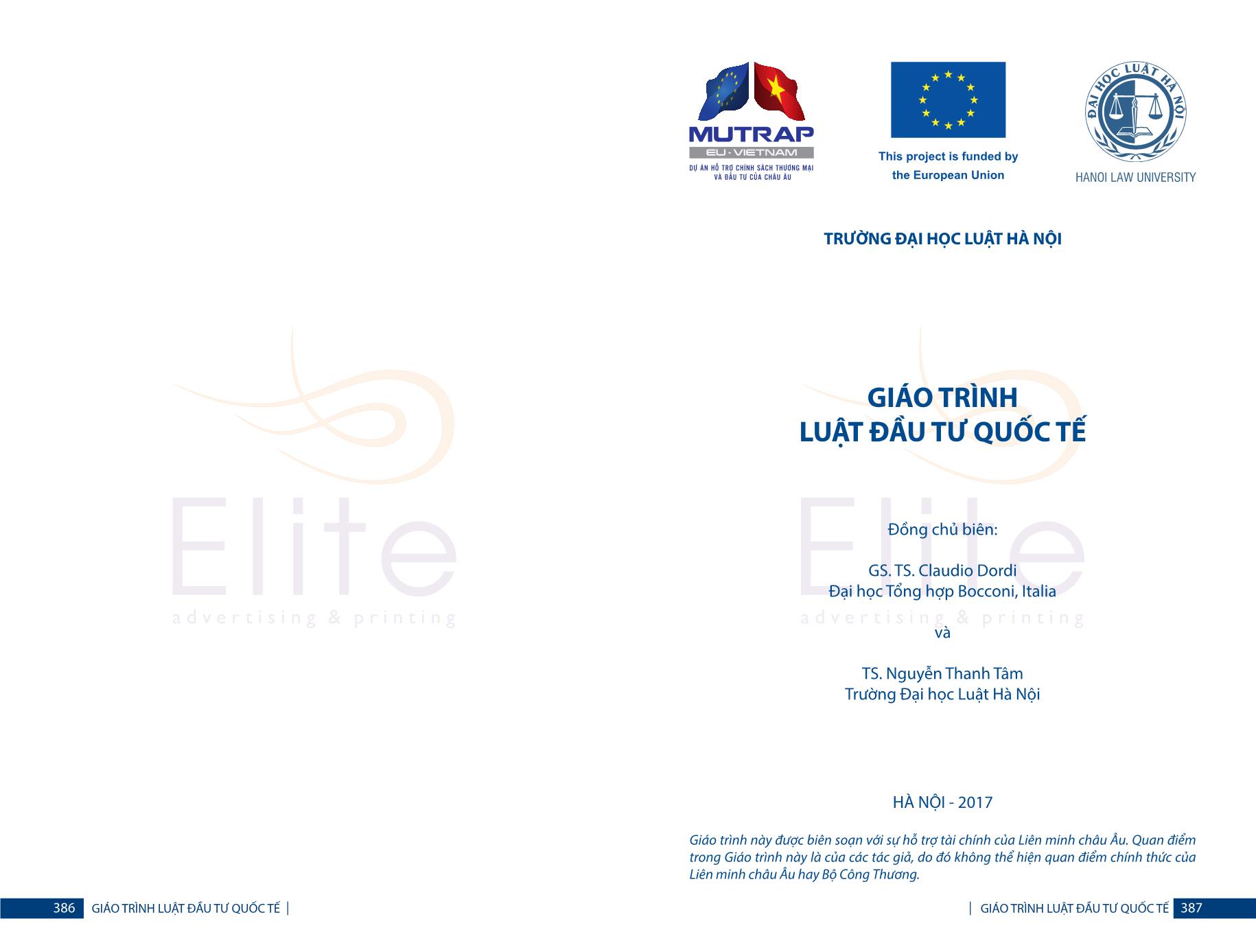
Trang 1
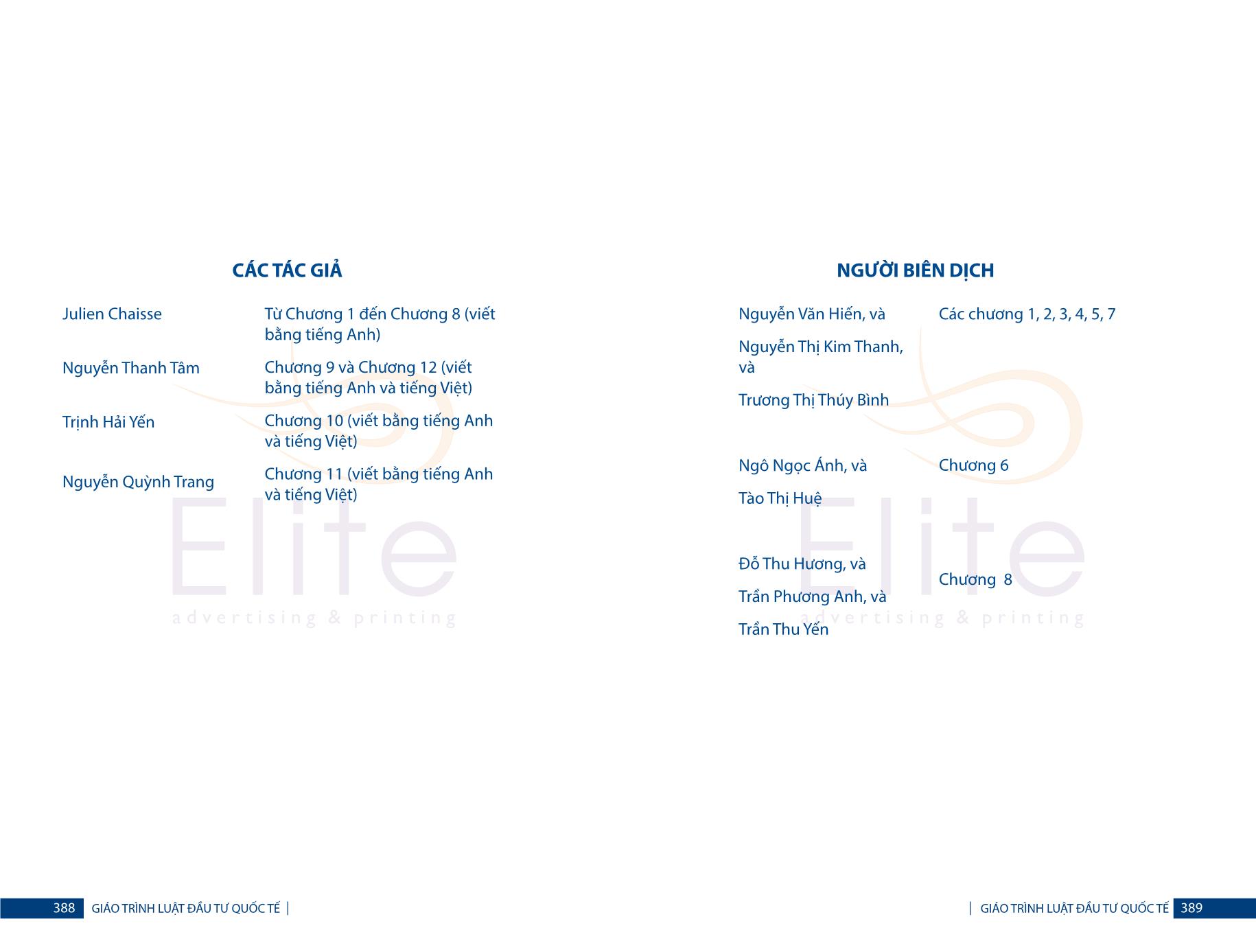
Trang 2
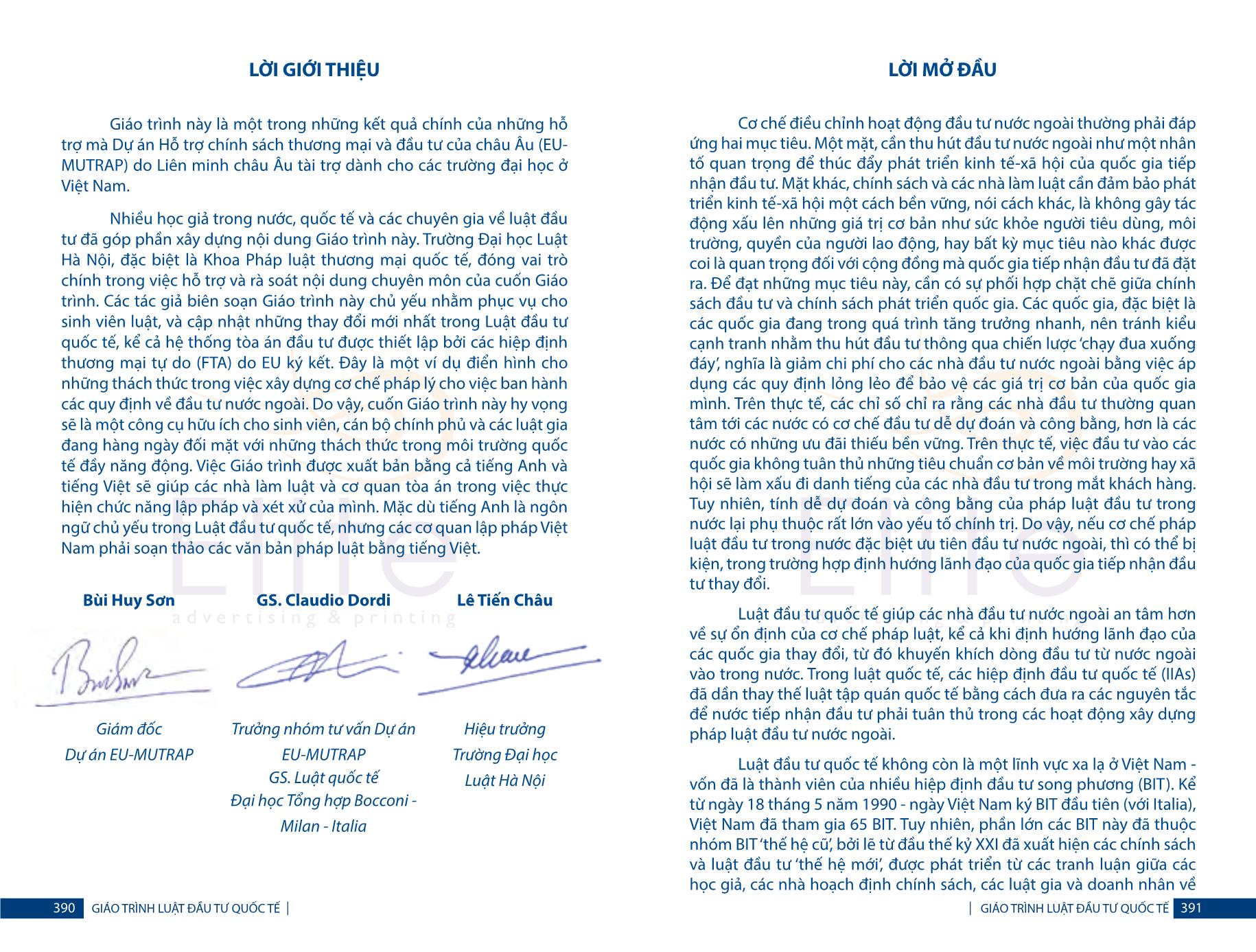
Trang 3
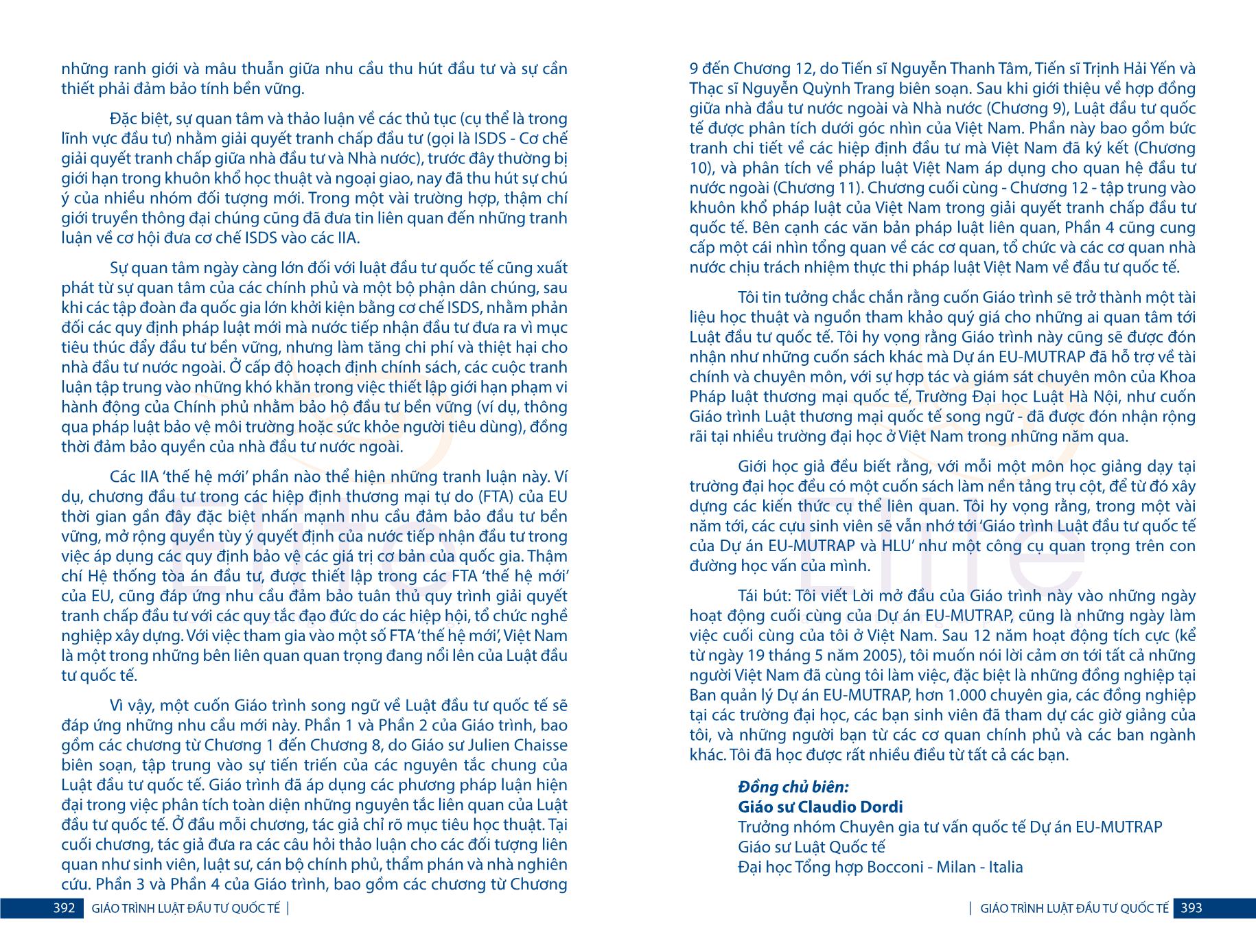
Trang 4
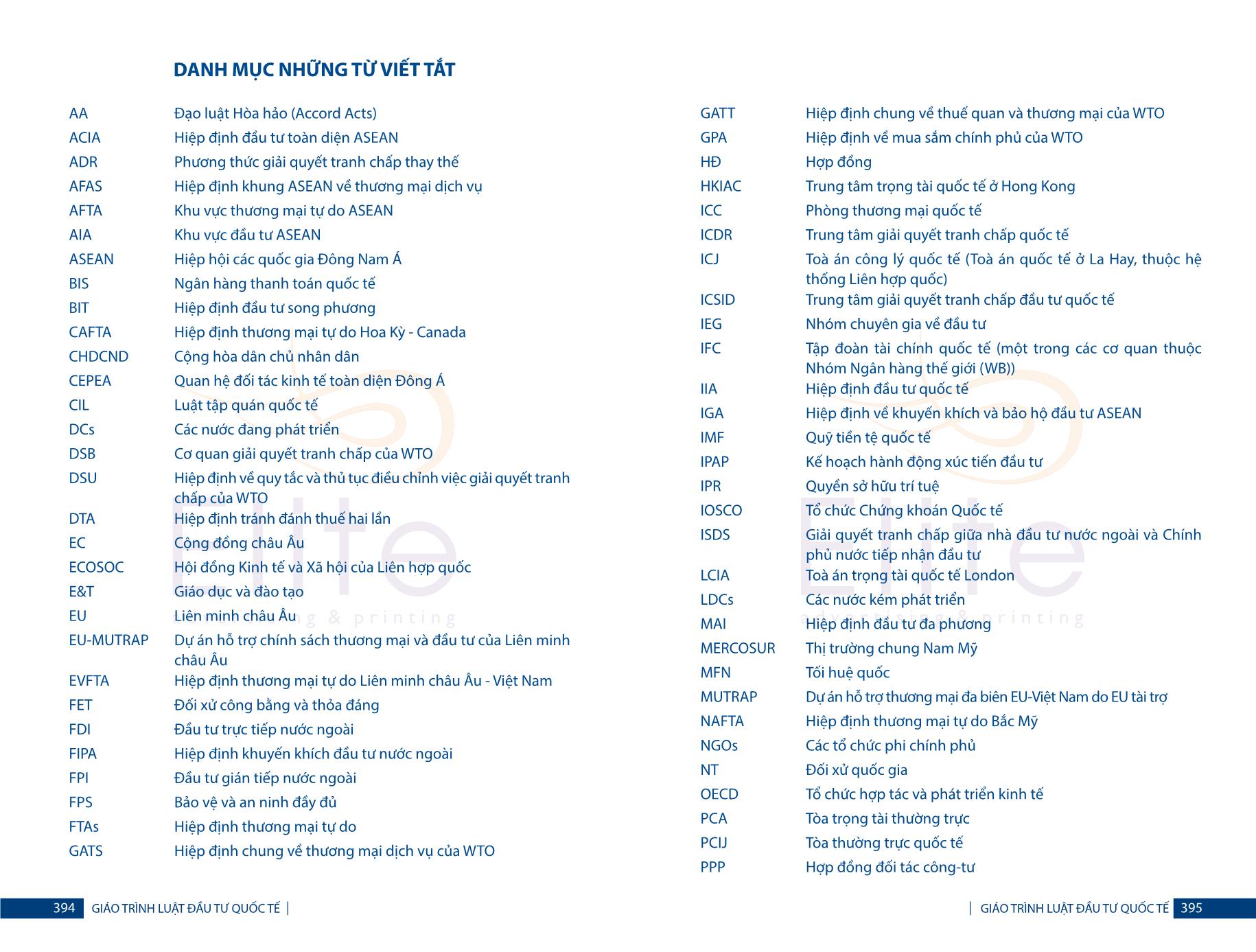
Trang 5
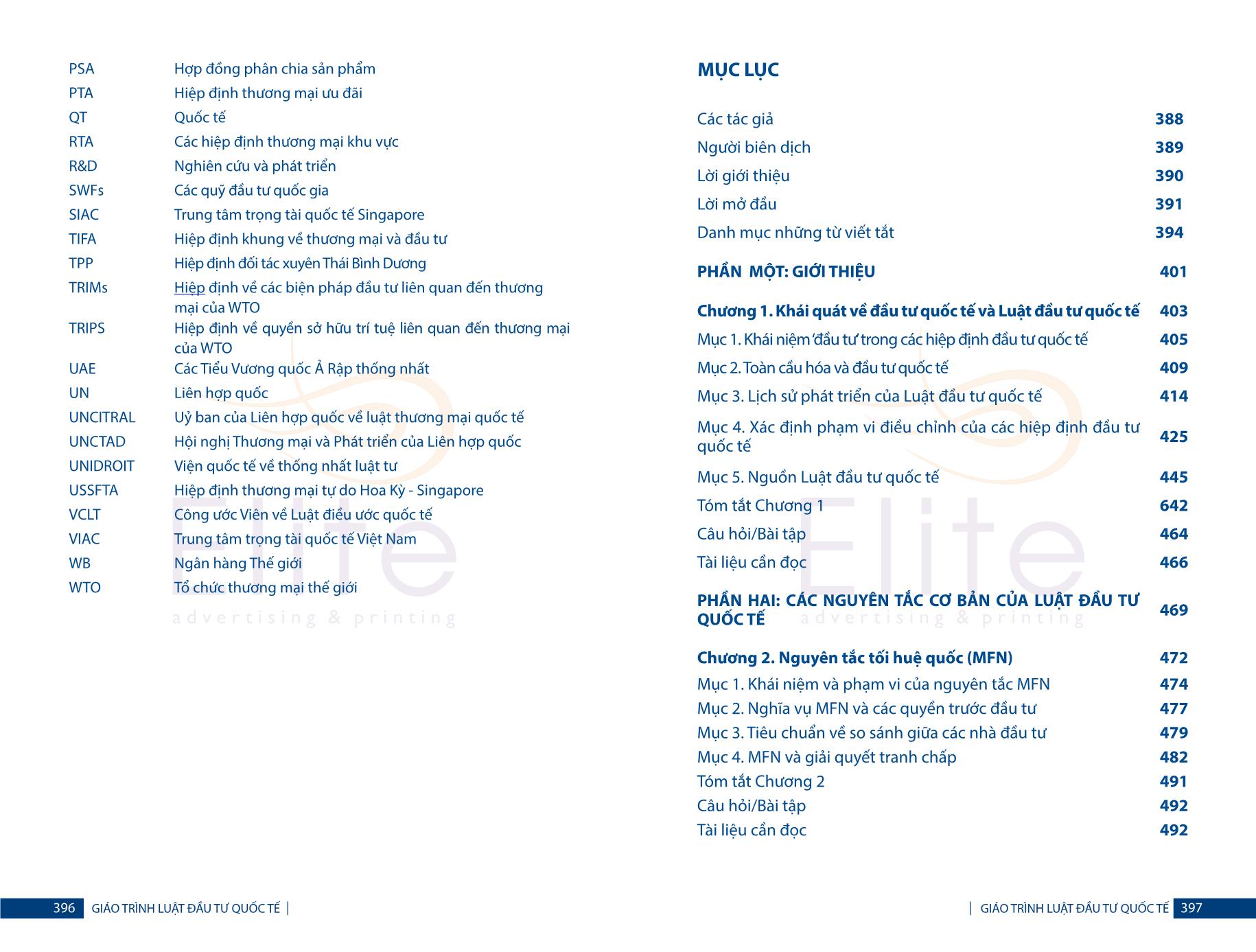
Trang 6
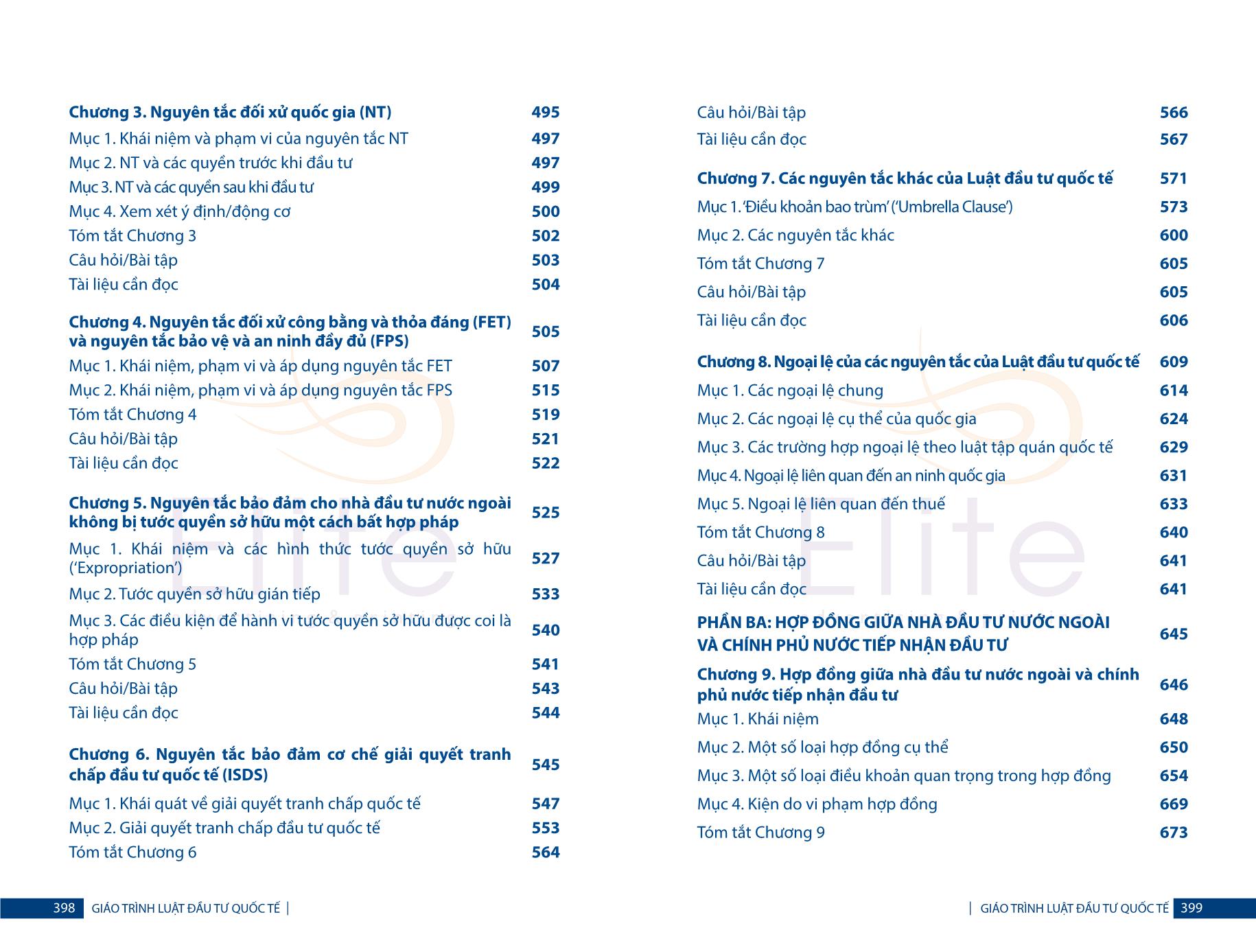
Trang 7
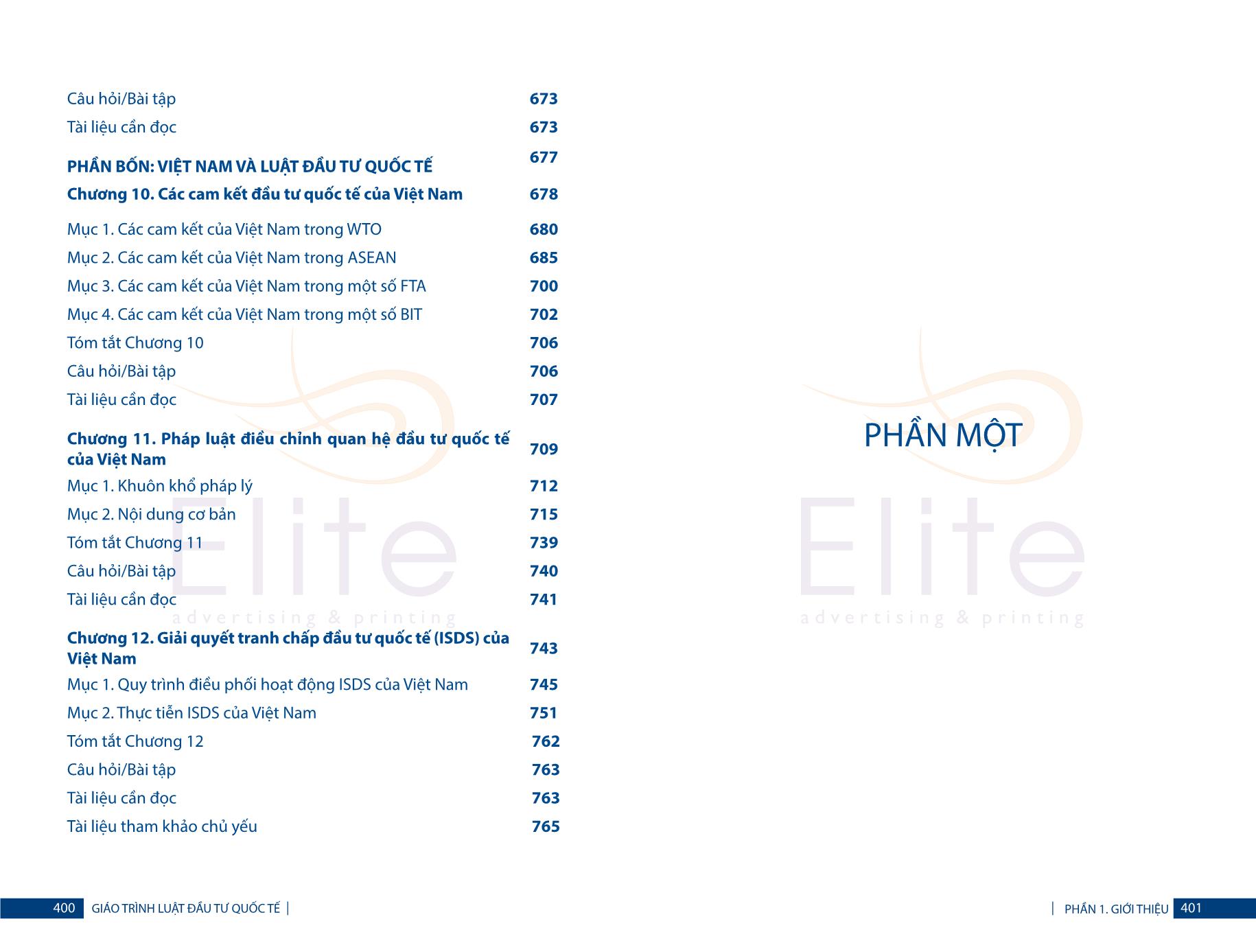
Trang 8
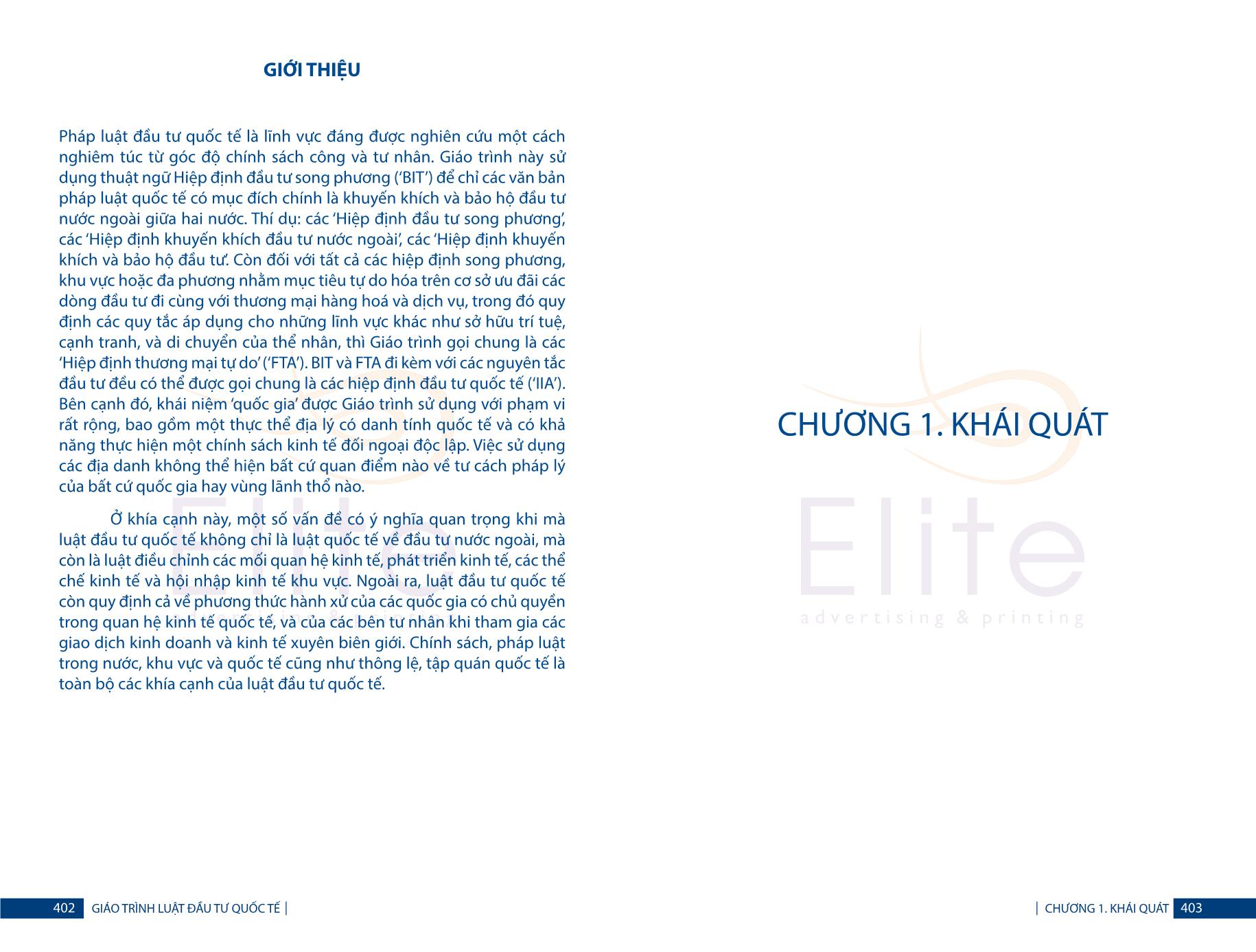
Trang 9
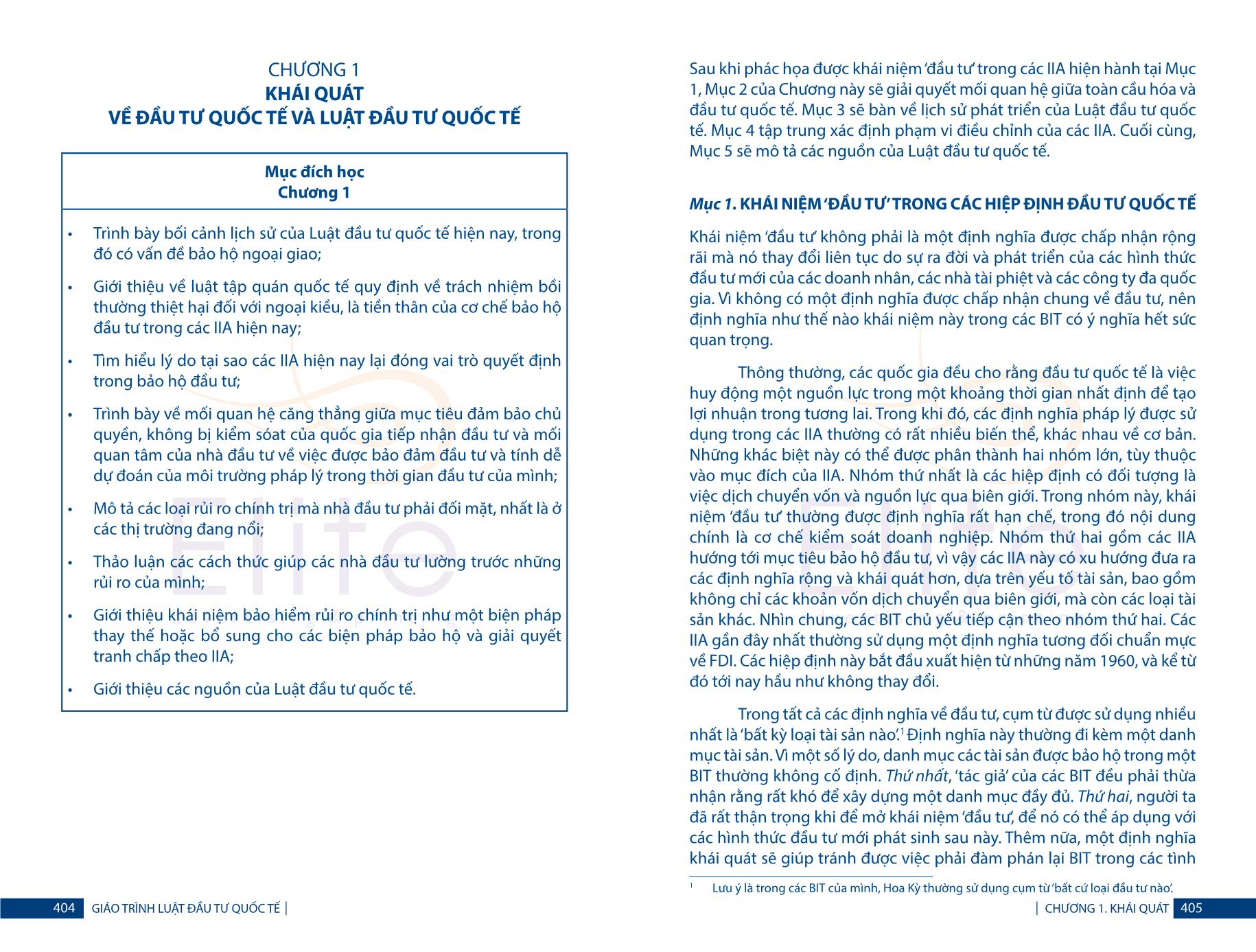
Trang 10
Tải về để xem bản đầy đủ
Tóm tắt nội dung tài liệu: Giáo trình Luật đầu tư quốc tế
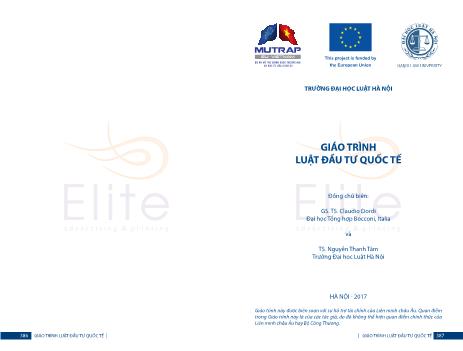
, CuRRent issues III, at 241 (Andrea K. Bjorklund, Ian A. Laird & Sergey Ripinsky eds., BIICL 2009). 30. stephan w. sChill, the multIlateralIzatIon of InternatIonal Investment law 121-196 (Cambridge 2009). 31. Peter Clark, National Treatment under GATT and NAFTA: A Discussion Comment, 1:3 tRansnational Dispute management (July 2004). 32. Andrea K. Bjorklund, National Treatment, in stanDaRDs of tReatment 29, 29-36 (August Reinisch ed., Oxford, 2008). 33. Susan D. Franck, International Decisions: Occidental Exploration and Production Co. v. Ecuador, 99 am. J. int’l L. 675 (2005). 34. Rudolf Dolzer, Fair and Equitable Treatment: A Key Standard in Investment Treaties” 39 the inteRnational lawyeR 87, 87-94; 100-06 (2005). 35. Schreuer, Fair and Equitable Treatment, BIICL, Investment Treaty Forum, 2:5 tRansnational Dispute management (November 2005). 36. Giuditta Cordero Moss, Full Protection & Security, in stanDaRDs of investment pRoteCtion 131, 138-150 (August Reinisch ed., Oxford 2008). 37. Lucy Reed &Daina Bray, Fair and Equitable Treatment: Fairly and Equitably Applied in Lieu of Unlawful Indirect Expropriation?, in ContempoRaRy issues in inteRnational aRBitRation anD meDiation 13 (Arthur Rovine ed., MartinusNijhoff 2008). 38. Meg Kinnear, The Continuing Development of the Fair and Equitable Treatment Standard, in investment tReaty law, CuRRent issues iii, at 209 (Andrea K. Bjorklund, Ian A. Laird & Sergey Ripinsky eds., BIICL 2009). 39. Peter Muchlinski, Caveat Investor? The Relevance of the Conduct of the Investor Under the Fair & Equitable Treatment Standard, 55 int’l & Comp. L. Q. 527 (2006). 40. UNCTAD, faIr & equItable treatment, UNCTAD/ITE/IIT/11 (Vol. III) (1999). 41. Todd Grierson-Weiler& Ian A. Laird, Standards Of Treatment, in oxfoRD hanDBook of inteRnational investment law 261 (Peter Muchlinski, Federico Ortino & Christoph Schreuer eds., 2008). 42. H.E. Zeitler, The Guarantee of ‘Full Protection and Security’ in Investment Treaties Regarding Harm Caused by Private Actors, 3 stoCkholm inteRnational aRBitRation Review 1 (2005). 43. Andrew Newcombe, The Boundaries of Regulatory Expropriation in International Law, 20 ICSID Review - foReign investment l. J. 1 (2005). 44. meg kinneaR, anDRea k. BJoRklunD & John f.g. hannafoRD, investment Disputes unDeR nafta: an annotateD guiDe to nafta ChapteR 11 at 1110.8 - 1110.58 (Kluwer 2006; last updated 2009). 45. Andrew Newcombe, The Boundaries of Regulatory Expropriation in International Law, 20 ICSID Review - foReign investment l. J. 1 (2005). 46. G.C. Christie, What Constitutes A Taking of Property under International Law? 38 BRIT. YB. INT’L L. 307 (1963). 47. Ursula Kriebaum, Regulatory Takings: Balancing the Interests of the Investor and the State, 8 J. woRlD investment & tRaDe 717 (2007). 48. Anne K. Hoffmann, Indirect Expropriation, in stanDaRDs of investment pRoteCtion 151 (August Reinisch ed., Oxford, 2008). 49. August Reinisch, Expropriation, in oxfoRD hanDBook of inteRnational investment law 407 (Peter Muchlinski, Federico Ortino& Christoph Schreuer eds., 2008). 770 771DANH MỤC TÀI LIỆU THAM KHẢO CHỦ YẾUGIÁO TRÌNH LUẬT ĐẦU TƯ QUỐC TẾ 50. August Reinisch & Loretta Malintoppi, Methods of Dispute Resolution, in oxfoRD hanDBook of inteRnational investment law 694, 694-702 (Peter Muchlinski, Federico Ortino& Christoph Schreuer eds., 2008). 51. Andrea K. Bjorklund, Reconciling State Sovereignty and Investor Protection in Denial of Justice Claims, 45 va. J. int’l l. 809, 820-25 (2005). 52. Nigel Blackaby, Investment Arbitration and Commercial Arbitration (or the Tale of the Dolphin and the Shark), in peRvasive pRoBlems in inteRnational aRBitRation 217-233 (Loukas A. Mistelis& Julian D.M. Lew eds., Kluwer 2006). 53. Emmanuel Gaillard, Vivendi and Bilateral Investment Treaty Arbitration, new yoRk l.J. (Feb. 26, 2003). 54. Claudia T. Salomon, Selecting An International Arbitrator: Five Factors to Consider, 17(10) MEALEY’S inteRnational aRBitRation RepoRt 25-28 (Oct. 2002). 55. Judith Levine, Dealing with Arbitrator “Issue Conflicts” in International Arbitration, 5(4) TDM (July 2008). 56. ICSID, the ICsId Caseload - statIstICs (Issue 2010-2), pp. 8-17. 57. inteRnational institute foR sustainaBle Development, prIvate rIghts/publIC problems 15-20 (2001). 58. Ucheora Onwuamaegbu, International Dispute Settlement Mechanisms - Choosing Between Institutionally Supported and Ad Hoc; and between Institutions, in aRBitRation unDeR inteRnational investment agReements: a guiDe to the key issues 63 (Katia Yannaca- Small ed., Oxford 2010). 59. Jan Paulsson, Arbitration Without Privity, 10 iCsiD Review - foReign investment L. J. 232 (1995). 60. Pieter H.F. Bekker, The Use of Non-Domestic Courts For Obtaining Domestic Relief: Jurisdictional Conflicts Between NAFTA Tribunals and U.S. Courts?, 11(2) ILSA JouRnal of inteRnational anD CompaRative law 331-342 (2005). 61. Osvaldo Marzorati, Algunas Reflxioness obre el Alcance de la Protección de las Inversionesen el marco de los Trata dos firma dos por Argentina, 1 Revista peRuana De aRBitRaJe, 71-118 (EditoralJurídicaGrijley (2005) 62. Doak Bishop & Lucy Reed, Practical Guidelines for Interviewing, Selecting and Challenging Party-Appointed Arbitrators in International Commercial Arbitration (June 2001), available at SelectingArbitrators.pdf. 63. Christoph Schreuer, Traveling the BIT Route - Of Waiting Periods, Umbrella Clauses and Forks in the Road, 5 J. woRlD investment & tRaDe 231 (2004). 64. Nigel Rawding, Protecting Investments under State Contracts: Some Legal and Ethical Issues, 11(4) aRB. int’l 341-45 (1995). 65. Emmanuel Gaillard, Investment Treaty Arbitration and Jurisdiction over Contract Claims - the SGS Cases Considered, in International Investment Law and Arbitration 325-46 (Todd Weiler ed., Cameron May 2005) (2005). 66. Thomas W. Wälde, The “Umbrella Clause in Investment Arbitration - A Comment on Original Intentions and Recent Cases, 6 J. woRlD investment & tRaDe 183 (2005); available at 1:4 Transnational Dispute Management (October 2004), pp. 1-4; 15-28. 67. Anne K. Hoffmann, Counterclaims by the Respondent State in Investment Arbitrations, sChieDsvZ 2006, Heft 6, at 317. 68. Zadek, The Path to Corporate Responsibility, haRvaRD Business Review125 (December 2004). 69. Luke Eric Peterson, Miner’s Claim against South Africa Moves forward Slowly, 1:13 investment aRB. Rep. (22 Oct. 2008). 70. Charles H. Brower, II, Obstacles and Pathways to Consideration of the Public Interest in Investment Treaty Disputes, in 1 yB. on int’l investment law & poliCy 347, 347-56; 365-78 (2008/2009) 71. Andrea Shemberg, Stabilization Clauses and Human Rights, Research Project Conducted for International Finance Corporation and the UN Special Representative to the Secretary General on Business and Human Rights (11 March 2008), available at S t a b i l i z a t i o n C l a u s e s a n d H u m a n R i g h t s / $ F I L E / Stabilization+Paper.pdf, pp. 4-16; 32-41. 72. Konrad von Moltke, IISD, a model InternatIonal Investment agreement for the promotIon of sustaInable development (2004), articles 11-24. 772 773DANH MỤC TÀI LIỆU THAM KHẢO CHỦ YẾUGIÁO TRÌNH LUẬT ĐẦU TƯ QUỐC TẾ 73. Katia Yannaca-Small, ‘What about this “Umbrella Clause”’?, in arbItratIon under InternatIonal Investment agreements: a guIde to the Key Issues 479 (Katia Yannaca-Small ed., Oxford 2010) 74. Anthony Sinclair, The Origins of the Umbrella Clause in the International Law of Investment Protection, 20 aRB. int’l 411 (2004). 75. Stanimir Alexandrov, Breach of Treaty Claims and Breach of Contract Claims: Is It Still Unknown Territory?, in aRBitRation unDeR inteRnational investment agReements: a guiDe to the key issues 323 (Katia Yannaca-Small ed., Oxford 2010) Andrea K. Bjorklund, Emergency Exceptions: State of Necessity and Force Majeure, in oxfoRD hanDBook of inteRnational investment law 459; 460-64; 507-16 (Peter Muchlinski, Federico Ortino& Christoph Schreuer eds., 2008). 76. Jürgen Kurtz, Adjudging the Exceptional at International Law: Security, Public Order and Financial Crisis, 59 int’l & Comp. L. Q. 325, 359-71 (2010). 77. José Alvarez & Kathryn Khamsi, The Argentine Crisis and Foreign Investors: A Glimpse into the Heart of the Investment Regime, 1 yB int’l investment l & poliCy 379, 449-460 (2009). 78. Martins Paparinskis, Investment Arbitration and the Law of Countermeasures, 79 BRit. y.B. int’l l. 264, 331-345 (2008). 79. Andrea K. Bjorklund, Economic Security Defenses in International Investment Law, 1 inteRnational investment law & poliCy yeaRBook 479 (2009). 80. Zachary Douglas, The Hybrid Foundations of Investment Treaty Arbitration, 74 BRit. y.B. int’l L. 151 (2003) 81. Andrea K. Bjorklund, Private Rights v. Public International Law: Why Competition Among International Courts and Tribunals Is Not Working, 59 hastings l. J. 241 (2007). 82. Mark S. Bergman, Bilateral Investment Protection Treaties: An Examination of the Evolution and Significance of the US Prototype Treaty, 16 n.y.u. J. int’l l. & pol. 1 (1983). 83. Julien Chaisse, Intellectual Property Rights, The Treaty Shopping Practice: Corporate Structuring and Restructuring to Gain Access to Investment Treaties and Arbitration, 11 Hastings int’l Bus. L.J. 225 (2015). 84. Asif H. Qureshi, Coherence in the Public International Law of Taxation: Developments in International Taxation and Trade and Investment Related Taxation, 10 asian J. wto & int’l health l. &pol’y 193(2015). 85. Julien Chaisse and Sufian Jusoh, The ASEAN Comprehensive Investment Agreement: The Regionalisation of Laws and Policy on Foreign Investment. (Cheltenham (UK) and Northampton (USA): Edward Elgar Publishing, 2016). 86. Jeswald W. Salacuse, The Law of Investment Treaties. (New York: Oxford University Press, 2105), pp. 98-99. 87. Diane A. Desierto, ‘Investment Treaties: ASEAN’ in Hal Hill, Maria Socorro GochocoBautista (eds) Asia Rising: Growth and Resilience in an Uncertain Global Economy (Edward Elgar Publishing Limited, 2013). 88. Trinh Hai Yen, ‘The ASEAN Comprehensive Investment Agreement”, in Paul Davidson (ed), Trading Arrangements in the Pacific Rim: ASEAN and APEC. (USDA: West Publishing Co, 2012). 89. Trinh Hai Yen, The Interpretation of Investment Treaties: Problems and Solution. (Leiden|Boston: Brill Nijhoff, 2014). 90. Trinh Hai Yen, Textbook on International Investment Law (Hanoi: National Political Publishing House, 2017), Chapter 9. 91. Hanoi Law University, Textbook on Investment Law (2009), The People’s Public Security Publishing House, Hanoi; 92. Le Huu Nghia, Le Van Chien, Nguyen Viet Thong, The Influence of Foreign Direct Investment on Labour Productivity and Technological Level of Viet Nam’ (2014), The National Political Publishing House - Truth, Hanoi; 93. Nguyen Thi Dung, ‘Enforcement of the Regulations on Banned Business Lines & Conditional Business Lines in Investment Law of 2014’ (January 2016), Journal of Law, Hanoi Law University. 774 775DANH MỤC TÀI LIỆU THAM KHẢO CHỦ YẾUGIÁO TRÌNH LUẬT ĐẦU TƯ QUỐC TẾ Legal Documents: 1. NAFTA 2. NAFTA FTC Notice of Interpretation. 3. Report No 89/TTr-CP dated April 10th 2014 on the Project of Investment Law; Cases: 1. Maffezini v. Spain (ICSID Case No. ARB/97/7), (Decision of the Tribunal on Objections to Jurisdiction) (25 January 2000), pages 14-25. 2. Plama Consortium Ltd v. Bulgaria, ICSID Case No. ARB/03/24 (Decision on Jurisdiction) (8 February 2005) 183-227. 3. National Grid PLC v. Argentina, UNCITRAL (Award) (3 Nov. 2008), 250-262. 4. LG&E v. Argentina, ICSID Case No. ARB/02/1 (Decision on Liability) (3 October 2006), 201-14; 226-66 5. Waste Management v. Mexico I & II (waiver, admissibility and jurisdiction); Waste Management I (Final Award (Dismissing on Jurisdiction)) (6/2/00), 4-7, 14-31.(Dissenting Opinion (on Jurisdiction)) (6/2/00), 10 – 28. 6. Waste Management II (Award on Jurisdiction, second claim) (6/26/02), 2-3, 19-37. 7. CMS Gas Transmission Co. v. Argentina, ICSID Case No. ARB/01/8 (Decision on Annulment) (24 September 2007), 101-50 8. Archer Daniels Midland Co. & Tate & Lyle Ingredients Americas, Inc. v. Mexico, ICSID Case ARB(AF)/04/06 (Award) (21 November 2007), 168-180 9. Corn Products Int’l v. Mexico, ICSID Case ARB(AF)/04/01 (Decision on Responsibility) (15 January 2008), 161-192. 10. Glamis Gold Ltd. v. United States of America, UNCITRAL (Award) (8 June 2009), 10-26. 11. Glamis Gold Ltd. v. United States of America, UNCITRAL (Non disputing party supplemental submission) (16 October 2006). 12. SGS Société Générale de Surveillance S.A. v. Islamic Republic of Pakistan, ICSID Case No. ARB/01/13 (Decision on Jurisdiction) (6 August 2003) 133-73. 13. S.G.S. Société Générale de Surveillance S.A. v. Republic of the Philippines, Case No. ARB/02/6 (Decision on Jurisdiction (29 January 2004), 92-97; 113-135. 14. El Paso Energy Int’l Co. v. Argentina, ICSID Case ARB/03/15 (Decision on Jurisdiction) (27 April 2006), 63-88. 15. Methanex Corp. v. United States of America, UNCITRAL (Final Award) (3 Aug. 2005), Part IV, Chapter B. 16. Occidental Exploration & Prod. Co. v. Republic of Ecuador, LCIA Case. No. UN 3467 (Final Award) (1 July 2004) 1-6, 25-35 (facts), 167-179. 17. Gami Investments Inc. v. Mexico, UNCITRAL, (Final Award) (15 November 2004) 12-22 (facts) 111-115. 18. Impregilo S.p.A. v. Argentine Republic, ICSID Case No. ARB/07/17, Concurring and Dissenting Opinion of Professor Brigitte Stern, 21 June 2011 19. Glamis GoldLtd. v. United States of America, UNCITRAL (Award) (8 June 2009) 10-15 (facts); 598-626. 20. Merrill & Ring Forestry L. P. v. Canada, UNCITRAL (Award) (31 March 2010) 26-43 (facts); 182-233 21. Wena Hotels Ltd. v. Egypt, ICSID Case ARB/98/4 (Award) (8 December 2000), 15-69; 80-95. Websites: 1. UNCTAD, 2. 3. 4. NHÀ XUẤT BẢN THANH NIÊN Trụ sở: 64 Bà Triệu, Hoàn Kiếm, Hà Nội Tel: 024 62 63 1720 - 098 25 26 569 Website: Chịu trách nhiệm xuất bản GIÁM ĐỐC Nguyễn Xuân Trường Biên tập: Nguyễn Thị Kim Thu LIÊN KẾT XUẤT BẢN Nguyễn Minh Hùng: HĐLK 498 In 700 bản, khổ 16 x 24 cm tại Công ty CP in Thiên Hà Địa chỉ: Đội 8, Đình Thôn, phường Mỹ Đình 1, quận Nam Từ Liêm, TP. Hà Nội. Số xác nhận ĐKXB: 2139 - 2017/CXBIPH/ 6-98/TN. Quyết định xuất bản số: 1166/QĐ-NXBTN cấp ngày 07 tháng 12 năm 2017. In xong và nộp lưu chiểu năm 2017. Mã ISBN: 978-604-64-8246-0 GIÁO TRÌNH LUẬT ĐẦU TƯ QUỐC TẾ TEXTBOOK ON INTERNATIONAL INVESTMENT LAW Room 1203, 12th oor, o ce area Ha Noi Tower, 49 Hai Ba Trung str., Hoan Kiem dist., Ha Noi Tel: 84-24-3937 8472 - Fax: 84-24-3937 8476 Email: mutrap@mutrap.org.vn - Website: www.mutrap.org.vn
File đính kèm:
 giao_trinh_luat_dau_tu_quoc_te.pdf
giao_trinh_luat_dau_tu_quoc_te.pdf

